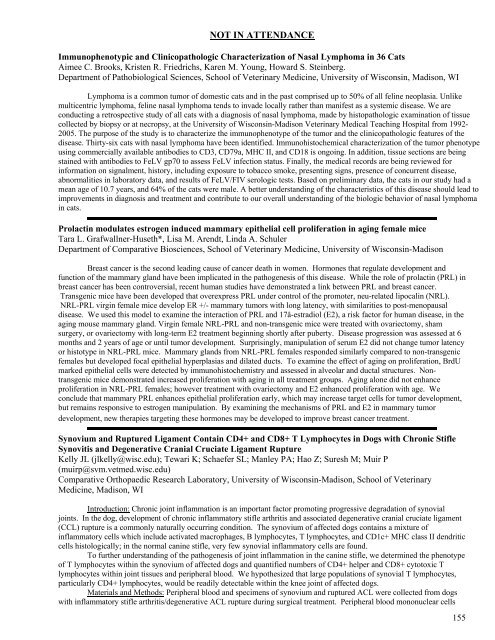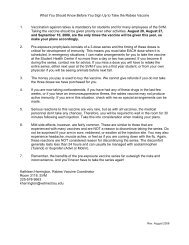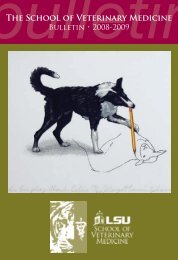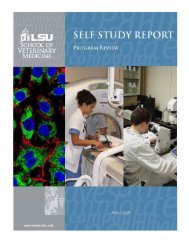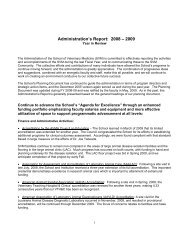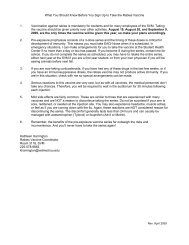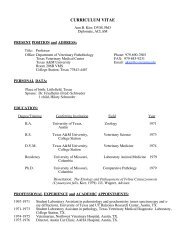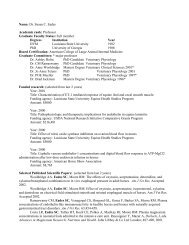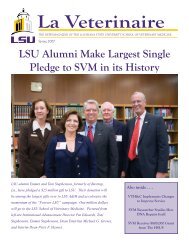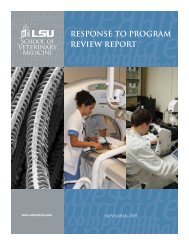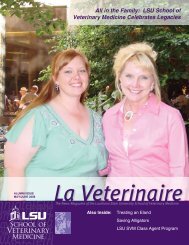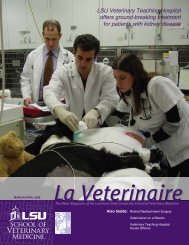eeding grounds near Minnedosa, MB spring <strong>of</strong> 2004 and near St. Denis, SK spring <strong>of</strong> 2005 and <strong>2006</strong>. Fall samples werecollected from waterfowl trapped in large bait traps at banding stations south <strong>of</strong> Moose Jaw, SK in 2004 and 2005. Sampleswere also collected from hunter-killed ducks in fall <strong>of</strong> 2005. Blood samples (3 ml) were collected from the right jugular vein<strong>of</strong> live-caught birds and ducks were classified according to age, sex and species. Samples were centrifuged at 4000 rpm for 8minutes and serum was stored for further analysis at -80¨¬C. Serum samples were tested for presence <strong>of</strong> neutralizingantibodies using WNV-specific blocking ELISA. A sample was considered positive for WNV if the absorbance valuedetermined by ultraviolet spectrophotometry was ¡Â 70% <strong>of</strong> the absorbance value <strong>of</strong> the negative reference serum. Betweenspring <strong>of</strong> 2005 and <strong>2006</strong>, 440 samples were collected from Mallards (Anas platyrhynchos), Blue-winged Teal (Anas discors),Northern Pintails (Anas acuta) and Redheads (Aythya americana). Initial results have shown 18% prevalence <strong>of</strong> WNVantibodies in adult male mallards in fall <strong>of</strong> 2005 compared to 10% prevalence in spring <strong>of</strong> <strong>2006</strong>. Juvenile male mallards showthe reverse trend, 0% prevalence in fall <strong>of</strong> 2005 compared to 18.5% prevalence in spring <strong>of</strong> <strong>2006</strong>. Further analysis isunderway to compare trends <strong>of</strong> male mallard populations to prevalence <strong>of</strong> WNV antibody in different species, sexes, andages <strong>of</strong> waterfowl.An Epidemiological Study <strong>of</strong> Leptospirosis in Champaign County CaninesJacqueline Scapa*, Dr. Marylin Ruiz, Dr. NamJung Jung, and Dr. Carol Maddox<strong>Veterinary</strong> Diagnostic Laboratory/Department <strong>of</strong> <strong>Veterinary</strong> Pathobiology, College <strong>of</strong> <strong>Veterinary</strong> <strong>Medicine</strong> at theUniversity <strong>of</strong> Illinois at Urbana, Champaign.Leptospirosis is a bacterial disease caused by any one <strong>of</strong> sixteen species and 2,000 serovars <strong>of</strong> the spirocheteLeptospira. This study is designed to examine the correlation between cases <strong>of</strong> Leptospirosis in the canine population <strong>of</strong>Champaign County and ponds or other bodies <strong>of</strong> water containing Leptospira. Suburban retention ponds in the new housingdevelopments <strong>of</strong> Champaign County may serve as exposure sites for pets and pet owners who frequent the area on walks orduring other recreational activities. Advanced GIS s<strong>of</strong>tware and GPS mapping has permitted the selection <strong>of</strong> ponds based ontheir proximity to cases <strong>of</strong> canine Leptospirosis.Real-time Polymerase Chain Reaction was used to determine the presence <strong>of</strong> Leptospira in every pond sampled thusfar, providing evidence that these ponds, contaminated by wildlife with endemic Leptospira infections, may serve as thereservoirs responsible for the infection in canines. Investigation is currently underway to determine if these ponds containpathogenic Leptospira serovars.Epidemiology <strong>of</strong> feline pathogenic hemoplasma infectionsJeralyn Terry and Dr. Jane Sykes, BVSc(Hons), PhD, DACVIMDepartment <strong>of</strong> <strong>Medicine</strong> & Epidemiology<strong>School</strong> <strong>of</strong> <strong>Veterinary</strong> <strong>Medicine</strong>, University <strong>of</strong> California, DavisUntil recently, only two hemotropic mycoplasmas (hemoplasmas) were identified as causes <strong>of</strong> feline infectiousanemia: Mycoplasma haem<strong>of</strong>elis (Mhf) and Candidatus Mycoplasma haemominutum (Mhm). Recently, a third type <strong>of</strong>hemoplasma was identified as being prevalent in Swiss cats, which has been named Candidatus Mycoplasma turicensis(Mtc). In addition, an organism related to the newly discovered canine organism, Candidatus Mycoplasma haematoparvum(Mhp-like) was identified in two cats presenting to the UC Davis <strong>Veterinary</strong> Medical Teaching Hospital. Theseepierythrocytic bacteria are best diagnosed using the polymerase chain reaction (PCR), as cytological evaluation <strong>of</strong> bloodsmears has low sensitivity and specificity. Infection with Mhf or Mtc has been associated with anemia in immunocompetentcats, whereas Mhm appears only to cause anemia in immunosuppressed cats. In addition, Mhm has been described as havinga synergistic effect with underlying retroviral (FeLV) infections in causing anemia and possible progression <strong>of</strong>myeloproliferative disease.We hypothesize that other unidentified types <strong>of</strong> hemoplasmas may be prevalent in anemic cats throughout theUnited <strong>State</strong>s, and that in contrast to a recent study in Europe, hemoplasma infection is associated with retroviral infection inthe United <strong>State</strong>s. The purpose <strong>of</strong> this study is to evaluate the prevalence, risk factors, and hematologic variables associatedwith hemoplasma infection in cats suspected to have hemoplasmosis from throughout the United <strong>State</strong>s. Blood smears andEDTA blood samples have now been collected through IDEXX Laboratories from over 300 cats that have had completeblood counts performed from various parts <strong>of</strong> the United <strong>State</strong>s. All samples will be tested using ELISA assays for FeLV andFIV. DNA will be extracted from samples using automated (Corbett) extraction methods. Each sample will be subjected toboth conventional and real-time PCR for Mhm, Mhf, and Mtc. PCR products from samples testing positive with conventionalbut not real-time PCR will be sequenced to determine whether a novel organism is present. The relationship betweeninfection with each hemoplasma species, signalment, geographic location, CBC results, retroviral status, and whether or notbacteria were visualized on cytology will be determined using appropriate statistical analyses.154
NOT IN ATTENDANCEImmunophenotypic and Clinicopathologic Characterization <strong>of</strong> Nasal Lymphoma in 36 CatsAimee C. Brooks, Kristen R. Friedrichs, Karen M. Young, Howard S. Steinberg.Department <strong>of</strong> Pathobiological Sciences, <strong>School</strong> <strong>of</strong> <strong>Veterinary</strong> <strong>Medicine</strong>, University <strong>of</strong> Wisconsin, Madison, WILymphoma is a common tumor <strong>of</strong> domestic cats and in the past comprised up to 50% <strong>of</strong> all feline neoplasia. Unlikemulticentric lymphoma, feline nasal lymphoma tends to invade locally rather than manifest as a systemic disease. We areconducting a retrospective study <strong>of</strong> all cats with a diagnosis <strong>of</strong> nasal lymphoma, made by histopathologic examination <strong>of</strong> tissuecollected by biopsy or at necropsy, at the University <strong>of</strong> Wisconsin-Madison <strong>Veterinary</strong> Medical Teaching Hospital from 1992-2005. The purpose <strong>of</strong> the study is to characterize the immunophenotype <strong>of</strong> the tumor and the clinicopathologic features <strong>of</strong> thedisease. Thirty-six cats with nasal lymphoma have been identified. Immunohistochemical characterization <strong>of</strong> the tumor phenotypeusing commercially available antibodies to CD3, CD79a, MHC II, and CD18 is ongoing. In addition, tissue sections are beingstained with antibodies to FeLV gp70 to assess FeLV infection status. Finally, the medical records are being reviewed forinformation on signalment, history, including exposure to tobacco smoke, presenting signs, presence <strong>of</strong> concurrent disease,abnormalities in laboratory data, and results <strong>of</strong> FeLV/FIV serologic tests. Based on preliminary data, the cats in our study had amean age <strong>of</strong> 10.7 years, and 64% <strong>of</strong> the cats were male. A better understanding <strong>of</strong> the characteristics <strong>of</strong> this disease should lead toimprovements in diagnosis and treatment and contribute to our overall understanding <strong>of</strong> the biologic behavior <strong>of</strong> nasal lymphomain cats.Prolactin modulates estrogen induced mammary epithelial cell proliferation in aging female miceTara L. Grafwallner-Huseth*, Lisa M. Arendt, Linda A. SchulerDepartment <strong>of</strong> Comparative Biosciences, <strong>School</strong> <strong>of</strong> <strong>Veterinary</strong> <strong>Medicine</strong>, University <strong>of</strong> Wisconsin-MadisonBreast cancer is the second leading cause <strong>of</strong> cancer death in women. Hormones that regulate development andfunction <strong>of</strong> the mammary gland have been implicated in the pathogenesis <strong>of</strong> this disease. While the role <strong>of</strong> prolactin (PRL) inbreast cancer has been controversial, recent human studies have demonstrated a link between PRL and breast cancer.Transgenic mice have been developed that overexpress PRL under control <strong>of</strong> the promoter, neu-related lipocalin (NRL).NRL-PRL virgin female mice develop ER +/- mammary tumors with long latency, with similarities to post-menopausaldisease. We used this model to examine the interaction <strong>of</strong> PRL and 17â-estradiol (E2), a risk factor for human disease, in theaging mouse mammary gland. Virgin female NRL-PRL and non-transgenic mice were treated with ovariectomy, shamsurgery, or ovariectomy with long-term E2 treatment beginning shortly after puberty. Disease progression was assessed at 6months and 2 years <strong>of</strong> age or until tumor development. Surprisingly, manipulation <strong>of</strong> serum E2 did not change tumor latencyor histotype in NRL-PRL mice. Mammary glands from NRL-PRL females responded similarly compared to non-transgenicfemales but developed focal epithelial hyperplasias and dilated ducts. To examine the effect <strong>of</strong> aging on proliferation, BrdUmarked epithelial cells were detected by immunohistochemistry and assessed in alveolar and ductal structures. Nontransgenicmice demonstrated increased proliferation with aging in all treatment groups. Aging alone did not enhanceproliferation in NRL-PRL females; however treatment with ovariectomy and E2 enhanced proliferation with age. Weconclude that mammary PRL enhances epithelial proliferation early, which may increase target cells for tumor development,but remains responsive to estrogen manipulation. By examining the mechanisms <strong>of</strong> PRL and E2 in mammary tumordevelopment, new therapies targeting these hormones may be developed to improve breast cancer treatment.Synovium and Ruptured Ligament Contain CD4+ and CD8+ T Lymphocytes in Dogs with Chronic StifleSynovitis and Degenerative Cranial Cruciate Ligament RuptureKelly JL (jlkelly@wisc.edu); Tewari K; Schaefer SL; Manley PA; Hao Z; Suresh M; Muir P(muirp@svm.vetmed.wisc.edu)Comparative Orthopaedic Research Laboratory, University <strong>of</strong> Wisconsin-Madison, <strong>School</strong> <strong>of</strong> <strong>Veterinary</strong><strong>Medicine</strong>, Madison, WIIntroduction: Chronic joint inflammation is an important factor promoting progressive degradation <strong>of</strong> synovialjoints. In the dog, development <strong>of</strong> chronic inflammatory stifle arthritis and associated degenerative cranial cruciate ligament(CCL) rupture is a commonly naturally occurring condition. The synovium <strong>of</strong> affected dogs contains a mixture <strong>of</strong>inflammatory cells which include activated macrophages, B lymphocytes, T lymphocytes, and CD1c+ MHC class II dendriticcells histologically; in the normal canine stifle, very few synovial inflammatory cells are found.To further understanding <strong>of</strong> the pathogenesis <strong>of</strong> joint inflammation in the canine stifle, we determined the phenotype<strong>of</strong> T lymphocytes within the synovium <strong>of</strong> affected dogs and quantified numbers <strong>of</strong> CD4+ helper and CD8+ cytotoxic Tlymphocytes within joint tissues and peripheral blood. We hypothesized that large populations <strong>of</strong> synovial T lymphocytes,particularly CD4+ lymphocytes, would be readily detectable within the knee joint <strong>of</strong> affected dogs.Materials and Methods: Peripheral blood and specimens <strong>of</strong> synovium and ruptured ACL were collected from dogswith inflammatory stifle arthritis/degenerative ACL rupture during surgical treatment. Peripheral blood mononuclear cells155
- Page 1 and 2:
2006 MERCK/MERIALNATIONAL VETERINAR
- Page 6 and 7:
3:00-3:30 pm BreakNovel therapy for
- Page 8 and 9:
KEYNOTE SPEAKERRonald Veazey, D.V.M
- Page 10 and 11:
Mini Symposium II:Fish Research: A
- Page 12 and 13:
David G. Baker, D.V.M., M.S., Ph.D.
- Page 14 and 15:
Konstantin G. Kousoulas, Ph.D.Profe
- Page 16 and 17:
Joseph Francis, B.V.Sc., M.V.Sc., P
- Page 18 and 19:
dogs with cancer, the potential rol
- Page 20 and 21:
2006 MERCK/MERIALVETERINARY SCHOLAR
- Page 22 and 23:
YOUNG INVESTIGATOR AWARD HONORABLE
- Page 24 and 25:
Mammary epithelial-specific deletio
- Page 26 and 27:
2006 MERCK/MERIALVETERINARY SCHOLAR
- Page 28:
Variation in Q-Tract Length of the
- Page 34:
Novel therapy for humoral hypercalc
- Page 38:
ALTERNATE:Micron-scale membrane sub
- Page 42 and 43:
ABSTRACT TITLES LISTED BY CATEGORY
- Page 44 and 45:
19. A pilot study of cigarette smok
- Page 46 and 47:
36. Development of a murine in vitr
- Page 48 and 49:
ABSTRACT TITLES LISTED BY CATEGORY
- Page 50 and 51:
71. Identification and characteriza
- Page 52 and 53:
85. Age and Gender Influence Ventil
- Page 54 and 55:
ABSTRACT TITLES LISTED BY CATEGORY
- Page 56 and 57:
2006 MERCK/MERIALVETERINARY SCHOLAR
- Page 58 and 59:
10. Preliminary estimation of risk
- Page 60 and 61:
ABSTRACT TITLES LISTED BY CATEGORY
- Page 62 and 63:
47. Osteoprotegerin and Receptor Ac
- Page 64 and 65:
61. A Comparison of Interaction Pat
- Page 66 and 67:
ABSTRACT TITLES LISTED BY CATEGORY
- Page 68 and 69:
ABSTRACT TITLES LISTED BY CATEGORY
- Page 70 and 71:
ABSTRACT TITLES LISTED BY CATEGORY
- Page 72 and 73:
2006 MERCK/MERIALVETERINARY SCHOLAR
- Page 74 and 75:
used to label avian heterophils for
- Page 76 and 77:
obtained via analysis of time and d
- Page 78 and 79:
0.71mg/dL; p=0.001). Values for hem
- Page 80 and 81:
mass and fecundity in prespawning w
- Page 82 and 83:
Equine Hoof Laminae Tissue Collecti
- Page 84 and 85:
Aspiration Pneumonia in DogsDavid A
- Page 86 and 87:
Distortion Product Otoacoustic Emis
- Page 88 and 89:
tyrosine phosphorylation is measure
- Page 90 and 91:
the gravid and non-gravid females t
- Page 92 and 93:
egulatory function as its ortholog,
- Page 94 and 95:
PATHOLOGY, TOXICOLOGY, AND ONCOLOGY
- Page 96 and 97:
Markers of Oxidative Stress in plas
- Page 98 and 99:
has been isolated from all samples
- Page 100 and 101:
Matrix metalloproteinase secretion
- Page 102 and 103:
Reproductive performance, neonatal
- Page 104 and 105: control to determine the efficiency
- Page 106 and 107: Enhancing the Quality and Reliabili
- Page 108 and 109: grade II MCTs into groups with good
- Page 110 and 111: Transcriptional Regulation of the I
- Page 112 and 113: MICROBIOLOGY AND IMMUNOLOGY (SESSIO
- Page 114 and 115: colonization of the mutant and 6 re
- Page 116 and 117: digestive tracts of these and other
- Page 118 and 119: 100 pfu BRSV. The results show that
- Page 120 and 121: Inhibition of Microneme Secretion i
- Page 122 and 123: Adherent bacilli were present in th
- Page 124 and 125: isolated to analyze cytokine gene e
- Page 126 and 127: purified, viral RNA was extracted a
- Page 128 and 129: The effects of co-engagement of TLR
- Page 130 and 131: Occurrence of Leptospira Vaccine Fa
- Page 132 and 133: undifferentiated catecholaminergic
- Page 134 and 135: the concept that the greater detoxi
- Page 136 and 137: quantitative PCR using gene targets
- Page 138 and 139: Rotenone Induced Dopamine Neuron De
- Page 140 and 141: decrease in serum cortisol, with a
- Page 142 and 143: and detrimental impacts on the brai
- Page 144 and 145: actions of cells prior to embryo de
- Page 146 and 147: Utilizing cDNA Subtraction to Exami
- Page 148 and 149: expression in unilaterally pregnant
- Page 150 and 151: Salmonella is increased. Poultry sa
- Page 152 and 153: exports. The estimated prevalence o
- Page 156 and 157: (PBMC) were isolated using commerci
- Page 158 and 159: 2006 MERCK/MERIALVETERINARY SCHOLAR
- Page 160 and 161: Trainees acquire in-depth knowledge
- Page 162 and 163: comparative pathology and/or resear
- Page 164 and 165: Department of Veterinary Bioscience
- Page 166 and 167: PhD, Director, Center for Comparati
- Page 168 and 169: 2006 MERCK/MERIALVETERINARY SCHOLAR
- Page 170 and 171: MICHIGAN STATEUNIVERSITYJames Crawf
- Page 172: UNIVERSITY OFPENNSYLVANIALindsay Th


